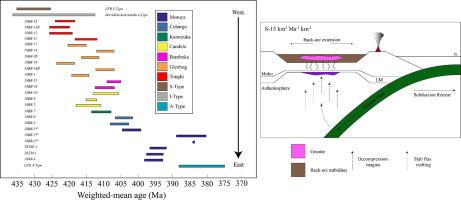Gondwana Research ( IF 7.2 ) Pub Date : 2022-07-16 , DOI: 10.1016/j.gr.2022.07.006 Jack E. Stirling , Anthony I.S. Kemp , Steven W. Denyszyn

|
Earth’s continental crust is primarily composed of buoyant, felsic igneous (granitic) material that has been extracted from the mantle along convergent plate margins. Establishing the timescales of subduction-related granite batholith assembly is key to understanding the processes of magma generation, segregation, and transport that define the dynamics and rates of crustal growth. The ‘Cordilleran’ Bega Batholith is the largest I-type granite batholith in the Lachlan Fold Belt (LFB) of south-eastern Australia. The product of accretionary orogenesis along the Terra Australis Orogen, it has been extensively characterised by isotopic and geochemical studies yet lacks a robust geochronological framework. We present new ID-TIMS and SHRIMP U-Pb zircon ages for twenty-two plutonic rocks of the Bega Batholith. This geochronological survey indicates a prolonged duration for I-type magmatism, with crystallisation ages ranging from ca. 420 Ma in the west, to 385 Ma in the eastern Bega Batholith. These I-type granites collectively occupy ∼90,000 km3 and were emplaced over a period of ∼20–35 Ma, corresponding to a magma production rate of ∼8–15 km3/Ma km−1, considerably lower than that of S-type granites of the region and other subduction-related granite terranes globally. Fundamentally, the temporal overlap between the Bega I-type granites and S- and A-type granites also argues against a hiatus between each phase of granite magmatism in the LFB, suggesting a continuum between the granite types and derivation from common source components. This new geochronological data provides the first comprehensive compilation of U-Pb ages from across the Bega Batholith, establishing initial constraints on the development and evolution of I-type magmatism in south-eastern Australia. Our results demonstrate that I-type granite petrogenesis is linked with crustal growth processes, requiring the modification of global crustal growth curves during the Phanerozoic to account for new continental crust generated within I-type granite terranes of the Paleo-Pacific Gondwanan margin.
中文翻译:

澳大利亚东南部志留纪-泥盆纪 Bega Batholith 的 U-Pb 年代学:I 型花岗岩成因和发育的见解
地球的大陆地壳主要由沿着会聚板块边缘从地幔中提取的具有浮力的长英质火成岩(花岗岩)物质组成。建立与俯冲相关的花岗岩基体组装的时间尺度是理解定义地壳生长动力学和速率的岩浆生成、分离和输送过程的关键。'Cordilleran' Bega Batholith 是澳大利亚东南部拉克兰褶皱带 (LFB) 中最大的 I 型花岗岩岩基。沿南大地造山带增生造山的产物,它已通过同位素和地球化学研究广泛表征,但缺乏稳健的地质年代学框架。我们提出了 Bega Batholith 的 22 块深成岩的新 ID-TIMS 和 SHRIMP U-Pb 锆石年龄。这项地质年代学调查表明 I 型岩浆作用的持续时间较长,结晶年龄从 ca. 西部420 Ma,东部Bega Batholith 385 Ma。这些I型花岗岩总面积约90,000公里3并在约 20-35 Ma 的时期内就位,对应的岩浆产量为 约 8-15 km 3 /Ma km -1, 远低于该地区的 S 型花岗岩和全球其他与俯冲有关的花岗岩地体。从根本上说,Bega I 型花岗岩与 S 型和 A 型花岗岩之间的时间重叠也反驳了 LFB 中每个花岗岩岩浆作用阶段之间的中断,这表明花岗岩类型之间存在连续性,并且来自共同的来源成分。这一新的地质年代学数据首次全面汇编了整个 Bega Batholith 的 U-Pb 年龄,为澳大利亚东南部 I 型岩浆活动的发展和演化建立了初步约束。我们的研究结果表明,I型花岗岩成因与地壳生长过程有关,











































 京公网安备 11010802027423号
京公网安备 11010802027423号